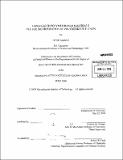Conjugated polymer based materials via the incorporation of polymerizable units
Author(s)
Kang, Hyun A
DownloadFull printable version (33.83Mb)
Other Contributors
Massachusetts Institute of Technology. Dept. of Chemistry.
Advisor
Timothy M. Swager.
Terms of use
Metadata
Show full item recordAbstract
Since the discovery of conducting polymers (CPs), efforts have focused on synthesizing CPs with improved processability, and finding new applications for the unique conjugated structure of CPs. This Thesis details the development of new CP based materials by block copolymerization and/or end-capping with polymerizable units. In Chapter 1, three different norbornene derivatives having phenylene-heterocyclic moieties were copolymerized with either norbornene or 7-oxanorbornene derivatives via ring-opening metathesis polymerization (ROMP). Block copolymers' stabilities and solubilities could be improved by hydrogenation of double bonds in the polymer backbone. The block copolymers were subsequently cross-linked by anodic electropolymerization of phenylene-heterocycle moieties, affording conducting polymers. All of these three block copolymers were readily deposited on the electrode substrates, and their cyclic voltammograms revealed an excellent reversibility in the redox cycles. The deposited polymer films also showed reversible color change between oxidized and neutral states. In Chapter 2, three different conjugated polymers having interesting properties and/or useful applications were synthesized and end-capped with norbornene using the hydroarylation reaction. These norbornene end-capped CPs became macroinitiators using Grubbs' catalysts, and they were used to prepare block copolymers by polymerizing ROMP monomers. (cont.) Prepared block copolymers were rubbery like outer elastomers while having similar optical properties to their center CPs. In Chapter 3, three different iptycene-poly(phenylene ethynylene)s, which were known to form well-aligned and chain-extended structures in nematic liquid crystals (LCs), were synthesized and end-capped with the compound capable of strong hydrogen bonding. Then, LC-polymer gels were prepared to see their effect on the vertically aligned nematic liquid crystal display's switching speed, particularly relaxation time. Prepared LC mixtures had similar phase transition temperature to pure LC. Unfortunately, the polymers could not improve the LC's switching speed in the vertically aligned mode probably because these polymers could not form a stable physical gel state within the LC test cell.
Description
Thesis (Ph. D.)--Massachusetts Institute of Technology, Dept. of Chemistry, 2009. Vita. Includes bibliographical references.
Date issued
2009Department
Massachusetts Institute of Technology. Department of ChemistryPublisher
Massachusetts Institute of Technology
Keywords
Chemistry.